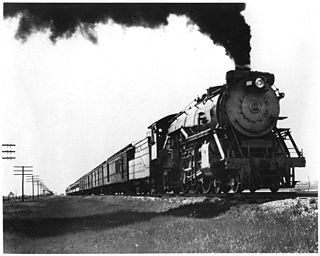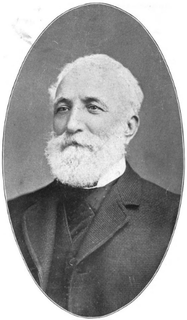Related Research Articles

The Chicago, Rock Island and Pacific Railroad was a Class I railroad in the United States. It was also known as the Rock Island Line, or, in its final years, The Rock.

The Chicago, Burlington and Quincy Railroad was a railroad that operated in the Midwestern United States. Commonly referred to as the Burlington Route, the Burlington or as the Q, it operated extensive trackage in the states of Colorado, Illinois, Iowa, Kansas, Kentucky, Missouri, Montana, Nebraska, Wisconsin, Wyoming, and also in New Mexico and Texas through subsidiaries Colorado and Southern Railway, Fort Worth and Denver Railway, and Burlington-Rock Island Railroad. Its primary connections included Chicago, Minneapolis-St. Paul, St. Louis, Kansas City and Denver. Because of this extensive trackage in the midwest and mountain states, the railroad used the advertising slogans "Everywhere West", "Way of the Zephyrs", and "The Way West".

Charles Morgan was an American railroad and shipping magnate. He played a leading role in the development of transportation and commerce in the Southern United States through the mid- to late-19th century.

The South Florida Railroad was a railroad from Sanford, Florida, to Tampa, Florida, becoming part of the Plant System in 1893 and the Atlantic Coast Line Railroad in 1902. It served as the southernmost segment of the Atlantic Coast Line's main line. The line remains in service today and is now part of the Central Florida Rail Corridor in the Orlando metro area. The rest of the line remains under the ownership of CSX Transportation as part of their A Line.

The Western Maryland Railway was an American Class I railroad (1852–1983) which operated in Maryland, West Virginia, and Pennsylvania. It was primarily a coal hauling and freight railroad, with a small passenger train operation.

The St. Louis Southwestern Railway Company, known by its nickname of "The Cotton Belt Route" or simply "Cotton Belt", is a former US Class I railroad which operated between St. Louis, Missouri, and various points in the states of Arkansas, Tennessee, Louisiana, and Texas from 1891 to 1980. In 1980 the Cotton Belt began operating the Rock Island's Golden State Route which added the states of Kansas, Oklahoma, and New Mexico to the operation. Operation of the Cotton Belt was assumed by parent Southern Pacific Transportation Company in 1992.

The Capital Subdivision is a railroad line owned and operated by CSX Transportation in the U.S. state of Maryland and the District of Columbia. The line runs from near Baltimore, Maryland, southwest to Washington, D.C., along the former Baltimore and Ohio Rail Road (B&O) Washington Branch. The subdivision's Alexandria Extension provides a connection to Virginia and points south.
The Buffalo Bayou, Brazos, and Colorado Railway, also called the Harrisburg Road or Harrisburg Railroad, was the first operating railroad in Texas. It completed its first segment of track between Harrisburg, Texas and Stafford's Point, Texas in 1853. The company established a western terminus at Alleyton, Texas prior to the Civil War. The railroad was sold after the war and reincorporated as the Galveston, Harrisburg, & San Antonio Railroad. This right of way was acquired by the Southern Pacific Railroad and is today a property of the Union Pacific Railroad.

The Fort Worth and Denver Railway, nicknamed "the Denver Road," was a Class I American railroad company that operated in the northern part of Texas from 1881 to 1982, and had a profound influence on the early settlement and economic development of the region.

The Texas and New Orleans Railroad was a railroad in Texas and Louisiana. It operated 3,713 miles (5,975 km) of railroad in 1934; by 1961, 3,385 miles (5,448 km) remained when it merged with parent company Southern Pacific.

The Gulf, Colorado and Santa Fe Railway was a subsidiary of the Atchison, Topeka & Santa Fe Railway in eastern Texas and to Purcell, Oklahoma.
The Beaumont, Sour Lake and Western Railway was an 85-mile (137 km) railroad that ran from Beaumont, Texas to Gulf Coast Junction in Houston. It passed through small southeast Texas communities such as Hull, Kenefick, and Huffman. As part of the Gulf Coast Lines system, the road was eventually merged into the Missouri Pacific Railroad in 1956, which in turn was merged into the Union Pacific Railroad in 1982. The Union Pacific still makes heavy use of the route.
The Burlington-Rock Island Railroad came into existence on July 7, 1930, through the reorganization of its predecessor, the Trinity and Brazos Valley Railway Company (T&BV), nicknamed the "Boll Weevil Line."
The Mankato Subdivision or Mankato Sub is a railway line operated by the Union Pacific Railroad. It runs generally southwest, starting at Chestnut Street in Saint Paul, Minnesota, where it crosses the Mississippi River, then runs south along the Mississippi and then the Minnesota River to Mankato, where it turns away from the river and continues west to St. James. From there Union Pacific's rails continue southwest toward Sioux City, Iowa, as the railroad's Worthington Subdivision.
The Houston and Texas Central Railway (H&TC), a predecessor of today's Union Pacific Railroad, was an 872-mile railway system chartered in Texas in 1848, with construction beginning in 1856. The line eventually stretched from Houston northward to Dallas and Denison, Texas. with branches to Austin and Waco.

The Trinity and Brazos Valley Railway of Texas came into existence on October 7, 1902, originally chartered to build a railroad from Johnson County to the Beaumont area near the Gulf coast. It took its name from the Trinity and Brazos rivers. It was commonly known as the “Boll Weevil," though it referred to itself as the "Valley Road."
The Delmarva Central Railroad is an American short-line railroad owned by Carload Express that operates 188 miles (303 km) of track on the Delmarva Peninsula in the states of Delaware, Maryland, and Virginia. The railroad operates lines from Porter, Delaware to Hallwood, Virginia and from Harrington, Delaware to Frankford, Delaware along with several smaller branches. The DCR interchanges with the Norfolk Southern Railway and the Maryland and Delaware Railroad. The railroad was created in 2016 to take over the Norfolk Southern Railway lines on the Delmarva Peninsula. The DCR expanded by taking over part of the Bay Coast Railroad in 2018 and the Delaware Coast Line Railroad in 2019.
The history of the Southern Pacific stretches from 1865 to 1998. For the main page, see Southern Pacific Transportation Company; for the former holding company, see Southern Pacific Rail Corporation.
The Santa Cruz and Monterey Bay Railroad (SCMB) was a railway line running through Santa Cruz County, California. It runs from Davenport to the Watsonville Junction where it connects to the Union Pacific.

Paul Bremond was an American businessman. He was a hatter, doing in business in New York City and Philadelphia, and from 1840, a commission merchant in Galveston, in the Republic of Texas.
References
- 1 2 Werner, George (February 20, 2017). "Galveston, Henderson and Houston Railroad". Handbook of Texas Online. Texas State Historical Association. Retrieved January 2, 2020.
- ↑ Houston Region Freight Study (Report). Texas Department of Transportation and HNTB Corporation. 2005. p. 98 (.pdf).